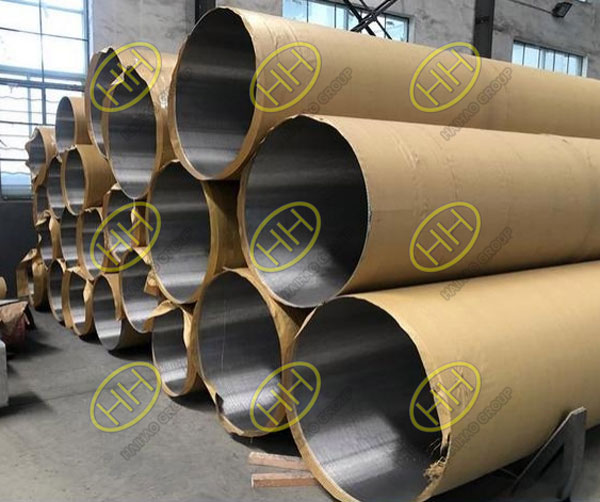ASTM A358 is a widely used specification for Electric Fusion Welded (EFW) austenitic stainless steel pipes, designed for high-temperature and corrosive service conditions. One of the most important features of ASTM A358 is the classification system from Class 1 to Class 5, which defines manufacturing method, inspection level, and heat treatment process.
This article aims to explain each Class under ASTM A358, helping engineers, project owners, and procurement professionals select the correct pipe for their specific applications.

ASTM A358 Steel Pipes are ready for shipment
What Is ASTM A358?
ASTM A358 covers welded austenitic stainless steel pipes in large diameters, primarily produced by Electric Fusion Welding (EFW). The pipe is typically used for:
- Chemical and petrochemical plants
- Desalination units
- High-temperature heat exchanger systems
- Pulp and paper industry
Pipes under this standard can range from NPS 16 to NPS 48 and above, and are typically specified according to ASME B36.19M dimensions.
ASTM A358 Classification Overview
The Classes define how the pipe is manufactured, welded, heat-treated, and inspected:
| Class | Welding Type | Radiographic Inspection | Heat Treatment | Weld Passes |
| Class 1 | Single-weld, with filler metal | 100% RT of weld seam | Solution annealed | One side only |
| Class 2 | Single-weld, with filler metal | No RT required | Solution annealed | One side only |
| Class 3 | Double-weld, with filler metal | 100% RT of weld seam | Solution annealed | Both sides (backing or double side) |
| Class 4 | Double-weld, with filler metal | No RT required | Solution annealed | Both sides |
| Class 5 | Single- or double-weld, without filler metal | 100% RT of weld seam | Solution annealed | Pressure fusion only (autogenous) |
Class-by-Class Explanation
Class 1:Single Weld + Filler Metal + 100% Radiography
Welded from one side using filler metal.
Requires 100% radiographic (X-ray) examination of the weld seam.
Heat treated by solution annealing to restore corrosion resistance.
Suitable for critical applications where weld integrity is paramount.
Typical Uses: High-purity process lines, pressure piping in chemical plants.
Class 2: Single Weld + Filler Metal + No Radiography
Similar to Class 1, but does not require radiographic testing.
Solution annealed after welding.
Lower inspection cost but less assurance on weld quality.
Typical Uses: Non-critical process piping, low-pressure systems.
Class 3: Double Weld + Filler Metal + 100% Radiography
Welded from both sides using filler metal.
100% RT of the weld seam ensures full penetration and defect-free joint.
Offers redundancy in welding ideal for thicker wall pipes or large-diameter systems.
Typical Uses: Pressure lines, seawater piping, heat exchangers, power plant piping.
Class 4: Double Weld + Filler Metal + No Radiography
Double-welded pipe without RT.
Still solution annealed, but lower inspection stringency.
Preferred when cost is a concern and weld seam is not exposed to extreme stress.
Typical Uses: Vent lines, non-pressure systems, structural piping.
Class 5: Autogenous Weld (No Filler Metal) + 100% Radiography
Welded without filler metal:fusion occurs by heating edges until they join.
100% radiographic inspection ensures integrity.
Used in high-purity industries, such as semiconductor, biopharma, or food processing, where no filler contamination is desired.
Typical Uses: Cleanroom piping, ultra-high-purity systems.
Summary Comparison Table
| Feature | Class 1 | Class 2 | Class 3 | Class 4 | Class 5 |
| Weld Type | Single | Single | Double | Double | Single/Double |
| Filler Metal | Yes | Yes | Yes | Yes | No |
| Weld Side | One | One | Both | Both | One or Both |
| Radiographic Test (RT) | 100% | None | 100% | None | 100% |
| Heat Treatment | Solution Annealed | Solution Annealed | Solution Annealed | Solution Annealed | Solution Annealed |
| Purity Requirements | Medium | Low | Medium | Low | High |
| Application Criticality | High | Low | High | Medium | Very High |
Selection Guidelines by Industry
| Industry | Recommended Class |
| Chemical / Petrochemical | Class 1 or 3 |
| Pulp & Paper | Class 2 or 4 |
| Seawater Desalination | Class 3 |
| High Purity (Food, Pharma) | Class 5 |
| General Utility Piping | Class 2 or 4 |
| Pressure Systems | Class 1 or 3 |
The ASTM A358 classification system provides flexibility for project requirements, balancing weld quality, cost, and application demands. Whether you’re sourcing large-diameter stainless steel pipes for high-pressure applications or clean piping for hygienic systems, selecting the correct Class ensures safe, efficient, and cost-effective performance.
At Haihao Group, we manufacture and supply all Classes under ASTM A358 with full documentation, third-party inspection, and custom sizes. Our stainless steel EFW pipes are widely used in power generation, petrochemical, and process industries worldwide.
Contact us today to learn more about ASTM A358 pipe solutions tailored to your project specifications. Email:sales@haihaogroup.com
Related Articles:
ERW vs EFW Steel Pipes: What’s the Difference?
What Is EFW Pipe? ASTM A358 GR 316 CL.3 vs ASTM A671 GR CC60 CL.22
What’s A672 electric fusion welded (EFW) steel pipe?
ASTM A671 CC70 Electric-Fusion-Welded Steel Pipe for Atmospheric and Lower Temperatures
ASTM A671 CC65 Electric-Fusion-Welded Steel Pipe for Atmospheric and Lower Temperatures







